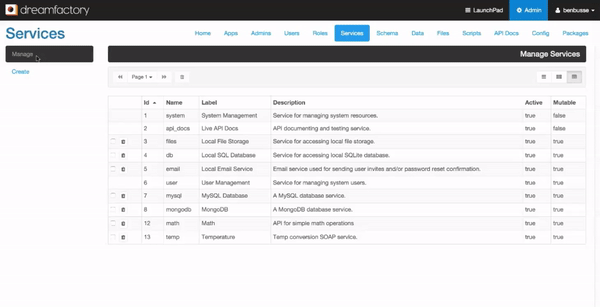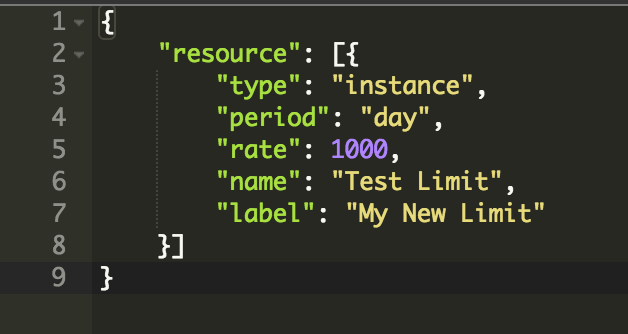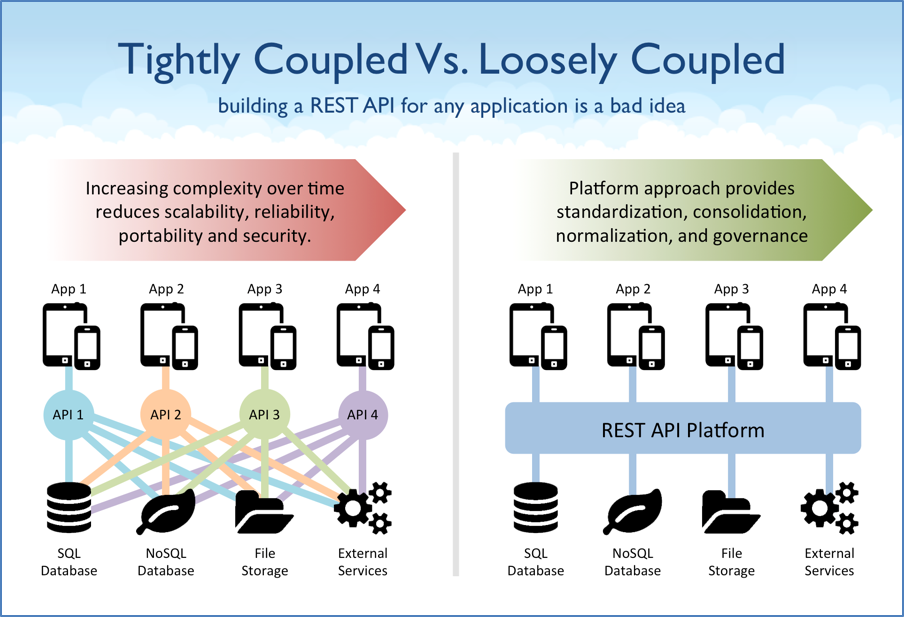6 Reasons to Use API Management | Dreamfactory
by Jeremy H • May 7, 2020

APIs (Application Performance Interfaces) have changed the way we build applications, and they’ve changed how applications communicate with each other. Essentially, APIs give enterprises the agility to rapidly and cost-effectively incorporate new services and updates into their applications and IT infrastructures.
Due to the tremendous advantages of API-based design, nearly every SaaS (Software as a Service) platform exposes APIs so enterprises and app developers can quickly integrate their solutions. Nevertheless, the immense proliferation of APIs is difficult to organize without an API management solution.
In this article, we’ll take a look at the six most important ways API management can help your enterprise achieve its app and IT development goals.
Did you know you can generate a full-featured, documented, and secure REST API in minutes using DreamFactory? Sign up for our free 14 day hosted trial to learn how! Our guided tour will show you how to create an API using an example database provided to you as part of the trial!
1. Standardize Security When Connecting to Third-Party Services
An API management solution helps you secure and control access to the data you expose to third-party services. For example, whether you’re connecting to a supply chain partner or a third-party SaaS, an API Manager like DreamFactory lets you instantly implement different authentication solutions:
“Secure every API endpoint behind Active Directory, OAuth2, Okta, OpenID Connect, and more; restrict capabilities using role associations for role-Based Access Controls; easily manage API keys; and, deploy behind firewalls and in air-gapped environments.”
Beyond authenticating access, you also need rules and strategies to prevent attacks and make sure sensitive information doesn’t leak into the wrong hands accidentally or intentionally. Here, API management tools allow you to standardized data security for your enterprise systems and ensure that all connections with third-party APIs adhere to those standards. If you’re following a common standard like GDPR, CCPD, SOC2 -- or a unique security standard of your own -- an API manager will strictly conform to these parameters for all API connections.
2. Standardize and Connect Disparate APIs
Not all APIs are the same and this can present challenges and slowdowns when it comes to setting up API connections. If you need to connect to various SOAP or REST APIs, the API manager will normalize and perform the different conversions needed for the disparate messaging protocols you’re dealing with.
In the case of DreamFactory, the platform allows you to automatically convert SOAP API to REST API -- which allows you to eliminate the biggest bottleneck in modern IT. By instantly creating and automatically creating a secure, standardized, reusable, fully documented, and live REST API for any database, the DreamFactory API manager lets you integrate disparate APIs into your projects, and launch them in a matter of weeks -- not the months it usually takes.
Here’s how simple it is to convert SOAP to REST with DreamFactory:

3. API Monitoring, Logging and Audit Trails
API management tools offer advanced monitoring through their logging and audit trail features for easier troubleshooting. Logging allows you to pinpoint system problems before they grow into a full-blown failure or outage. Audit trails help you figure out what went wrong after a serious problem has occurred.
An API manager can set up different kinds of logs and audit trails depending on the needs of the project. Logging usually relates to program-level instances, like administrator actions and abnormal events that developers can use for troubleshooting and debugging software. Audit trails usually relate to user actions, like changing an entry in the database by ‘Username’ at ‘12:00 p.m.’ on ‘May 7, 2020.’ At the end of the day, this kind of information is vital for keeping your systems running, and getting them fixed as quickly as possible after an emergency.
4. API Rate Limiting and Spike Arrest Features
An API manager can monitor APIs and implement API rate limiting, API quotas, and spike arrest features to prevent your internal systems from getting shut down by too much traffic. According to Nordicapis:
“Rate limiting is a critical component of an API product’s scalability. API owners typically measure processing limits in Transactions Per Second (TPS). Some systems may have physical limitations on data transference. Both are part of the Backend Rate Limiting. To prevent an API from being overwhelmed, API owners often enforce a limit on the number of requests, or the quantity of data clients can consume. This is called Application Rate Limiting. If a user sends too many requests, API rate limiting can throttle client connections instead of disconnecting them immediately. Throttling lets clients still use your services while still protecting your API.”
You can use your API manager to throttle requests when they exceed certain limits, trigger additional fees for new calls/requests, or determine whether new calls/requests will trigger an error code.
By identifying and slowing down IPs that exceed normal human activity, rate limiting can also prevent criminals from hacking your API with a malicious bot attack. Here’s how CloudFare describes this:
“Essentially, a rate-limited application will say, "Hey, slow down," to unique users that are making requests at a rapid rate. This is comparable to a police officer who pulls over a driver for exceeding the road's speed limit, or to a parent who tells their child not to eat so much candy in such a short span of time.”
To create a basic instance rate limit with the DreamFactory API Manager, you simply have to POST the following code to /api/v2/system/limit:

5. Organizes Useful APIs Into a Catalog
An API management platform like DreamFactory organizes the most useful APIs into a readily-accessible catalog. Similar to a product catalog, DreamFactory includes a variety of API listings that developers can choose from when creating an application.
In this way, an API catalog helps developers use, reuse, and even discover new APIs and services -- even ones they didn’t know existed. Thus, developers can rapidly leverage and reuse services and solutions for different business projects.
Here are some of the benefits of an API catalog:
- Adopt services/tools across different business departments and apps more easily
- Design custom solutions rapidly and cost-effectively by selecting APIs for the services/platforms/solutions your infrastructure requires
- Eliminate the need for tightly-coupled, point-to-point integrations
- Manage, organize, and discover the cloud-services API’s your applications will consume
Here are some of the listings in DreamFactory’s API catalog:

6. Support a Loosely-Coupled Application Architecture
A tightly-coupled application design creates interdependencies between the individual components that comprise a system. In other words, you might not be able to upgrade one part of a tightly-coupled system without negatively impacting other areas. For this reason, developers understand the value of a loosely-coupled design.
Nevertheless, when it comes to mobile applications, most are tightly-coupled to the REST APIs they depend on for operation. This is because developers usually create server-side APIs specific to each mobile app project. Every new application needs a custom, purpose-built REST API, resulting in a tightly-coupled design, and an architecture that lacks portability, scalability, reliability, and security.
As DreamFactory wrote in a recent blog:
“You should never develop a REST API for any specific application. This practice almost always results in an application that is tightly coupled to a custom-built service.”
An API manager supports a loosely-coupled design because it functions as an intermediary between the different APIs that form your architecture. This decouples your APIs, separating internal APIs from third-party APIs. Thus, instead of calling to an API directly, your app calls to the DreamFactory API Manager, which allows you to achieve the loosely-coupled architecture every developer wants.

By supporting a loosely-coupled application design, an API manager helps you:
- Achieve standardization, consolidation, normalization, and governance
- Create a pluggable application architecture or IT infrastructure
- Update services and features, or switch out a third-party SaaS provider, quickly and efficiently
- Implement changes more cost-effectively
- Bypass the usual implementation delays for upgrades
- Prevent upgrades from negatively impacting other areas of your system.
- Prevent coding conflicts
Final Thoughts on API Managers
After reading through this guide, you should have a clear understanding of the benefits of using an API management platform to support your app and IT infrastructure development tools. Ultimately, API management gives developers the tools they need to achieve greater agility, cost-effectiveness, scalability, reliability, and security when developing apps and business systems.
In this way, the DreamFactory API Management Platform offers a powerful way to rapidly build applications, automatically create REST APIs, and gain access to a collection of the most useful and popular APIs for app and IT infrastructure development.
Click this link for your free hosted trial and personalized tour of the DreamFactory platform.
TL;DR - GET AN AI SUMMARY
AI SUMMARY
READY TO BUILD YOUR API?
See how DreamFactory can automatically generate REST APIs for your database in minutes.
Try DreamFactory FreeFascinated by emerging technologies, Jeremy Hillpot uses his backgrounds in legal writing and technology to provide a unique perspective on a vast array of topics including enterprise technology, SQL, data science, SaaS applications, investment fraud, and the law.
























